AMD Ryzen 9 5980HS Cezanne Review: Ryzen 5000 Mobile Tested
by Dr. Ian Cutress on January 26, 2021 9:00 AM EST- Posted in
- CPUs
- AMD
- Vega
- Ryzen
- Zen 3
- Renoir
- Notebook
- Ryzen 9 5980HS
- Ryzen 5000 Mobile
- Cezanne
CPU Tests: Encoding
One of the interesting elements on modern processors is encoding performance. This covers two main areas: encryption/decryption for secure data transfer, and video transcoding from one video format to another.
In the encrypt/decrypt scenario, how data is transferred and by what mechanism is pertinent to on-the-fly encryption of sensitive data - a process by which more modern devices are leaning to for software security.
Video transcoding as a tool to adjust the quality, file size and resolution of a video file has boomed in recent years, such as providing the optimum video for devices before consumption, or for game streamers who are wanting to upload the output from their video camera in real-time. As we move into live 3D video, this task will only get more strenuous, and it turns out that the performance of certain algorithms is a function of the input/output of the content.
HandBrake 1.32: Link
Video transcoding (both encode and decode) is a hot topic in performance metrics as more and more content is being created. First consideration is the standard in which the video is encoded, which can be lossless or lossy, trade performance for file-size, trade quality for file-size, or all of the above can increase encoding rates to help accelerate decoding rates. Alongside Google's favorite codecs, VP9 and AV1, there are others that are prominent: H264, the older codec, is practically everywhere and is designed to be optimized for 1080p video, and HEVC (or H.265) that is aimed to provide the same quality as H264 but at a lower file-size (or better quality for the same size). HEVC is important as 4K is streamed over the air, meaning less bits need to be transferred for the same quality content. There are other codecs coming to market designed for specific use cases all the time.
Handbrake is a favored tool for transcoding, with the later versions using copious amounts of newer APIs to take advantage of co-processors, like GPUs. It is available on Windows via an interface or can be accessed through the command-line, with the latter making our testing easier, with a redirection operator for the console output.
We take the compiled version of this 16-minute YouTube video about Russian CPUs at 1080p30 h264 and convert into three different files: (1) 480p30 ‘Discord’, (2) 720p30 ‘YouTube’, and (3) 4K60 HEVC.
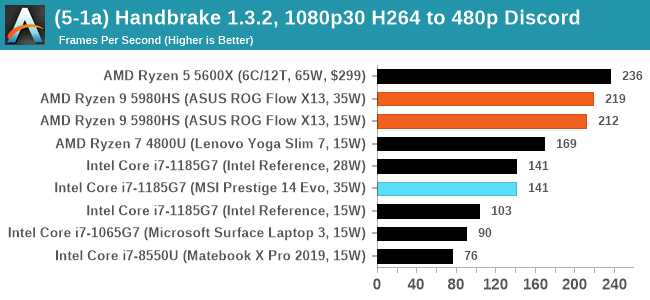
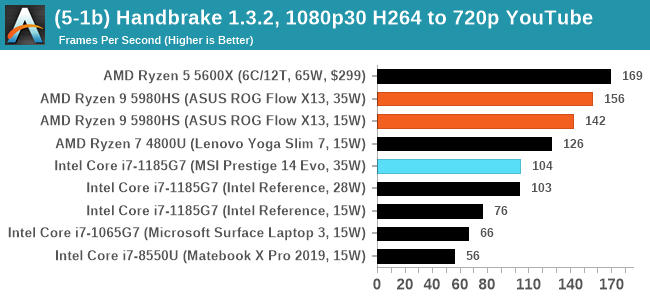
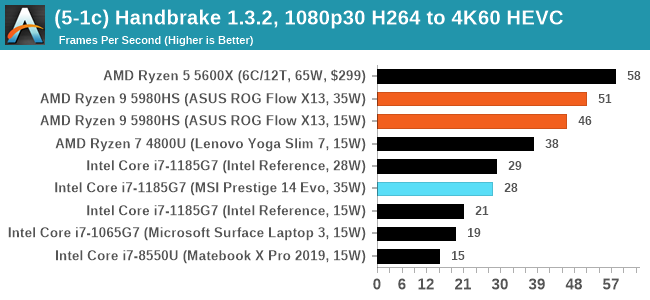
Threads wins, although the +30W difference to the desktop processor with two fewer cores can't be overhauled. Almost though.
7-Zip 1900: Link
The first compression benchmark tool we use is the open-source 7-zip, which typically offers good scaling across multiple cores. 7-zip is the compression tool most cited by readers as one they would rather see benchmarks on, and the program includes a built-in benchmark tool for both compression and decompression.
The tool can either be run from inside the software or through the command line. We take the latter route as it is easier to automate, obtain results, and put through our process. The command line flags available offer an option for repeated runs, and the output provides the average automatically through the console. We direct this output into a text file and regex the required values for compression, decompression, and a combined score.
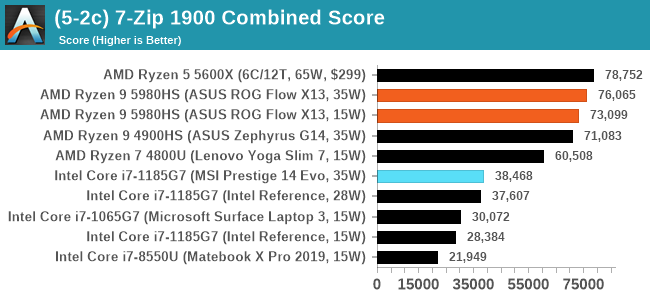
AES Encoding
Algorithms using AES coding have spread far and wide as a ubiquitous tool for encryption. Again, this is another CPU limited test, and modern CPUs have special AES pathways to accelerate their performance. We often see scaling in both frequency and cores with this benchmark. We use the latest version of TrueCrypt and run its benchmark mode over 1GB of in-DRAM data. Results shown are the GB/s average of encryption and decryption.
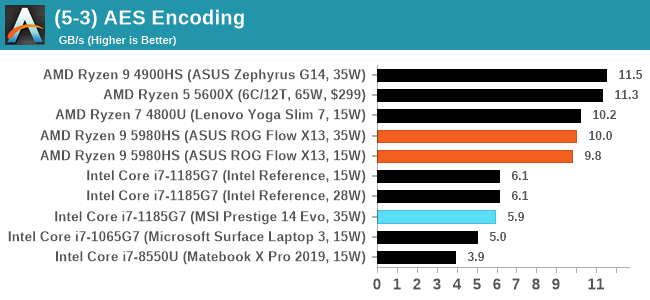
For our AES test here we actually had a small regression in performance. This could mean that there is additional performance hits to accessing the AES unit this time around, or the lower latency DDR4 of the Zephyrus is beating out the LPDDR4 on our Flow X13.
WinRAR 5.90: Link
For the 2020 test suite, we move to the latest version of WinRAR in our compression test. WinRAR in some quarters is more user friendly that 7-Zip, hence its inclusion. Rather than use a benchmark mode as we did with 7-Zip, here we take a set of files representative of a generic stack
- 33 video files , each 30 seconds, in 1.37 GB,
- 2834 smaller website files in 370 folders in 150 MB,
- 100 Beat Saber music tracks and input files, for 451 MB
This is a mixture of compressible and incompressible formats. The results shown are the time taken to encode the file. Due to DRAM caching, we run the test for 20 minutes times and take the average of the last five runs when the benchmark is in a steady state.
For automation, we use AHK’s internal timing tools from initiating the workload until the window closes signifying the end. This means the results are contained within AHK, with an average of the last 5 results being easy enough to calculate.

Another small performance uplift for WinRAR.


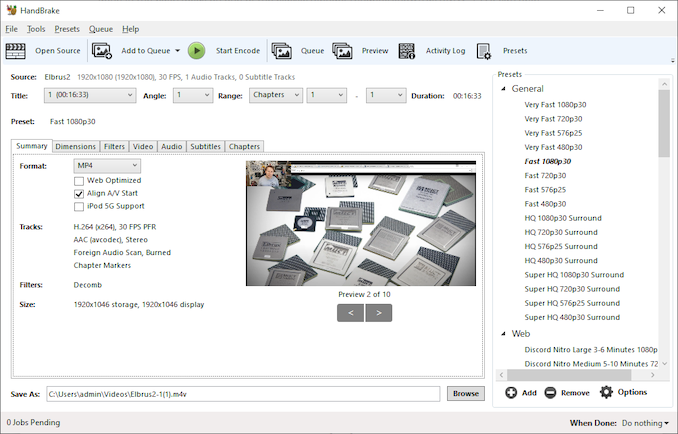
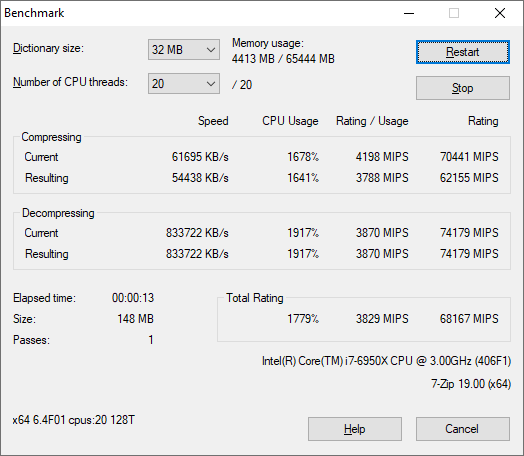









218 Comments
View All Comments
Makste - Thursday, January 28, 2021 - link
I've revised the charts, from what I've seen, the MSI Prestige Evo 14 is configured at 35W and happens to match performance with the intel reference configured at 28W. The biggest discrepancy I have seen between the two is in the y-Cruncher benchmark. However putting this one benchmark aside, intel's reference unit doesn't seem to differ greatly in performance from the shipping intel unit in the msi prestige evo 14.Spunjji - Friday, January 29, 2021 - link
Having gone over things again more carefully, I definitely overstated things when I said "annihilate", but in the tests where they both appear the Intel reference platform at 28W is faster than the MSI Prestige at 35W more often than the other way around (16-13). When the MSI does win, it's often not by much, and there are even 7 examples where the Intel reference platform at 15W beats the MSI at 35W - usually single-thread tests.My best guess is that the Intel platform might be showing some sort of latency advantage, possibly related to how quickly it can shift between speed states - which would favour it in the shorter and/or more lightly-threaded tests. I'd love to see a detailed analysis, though - ideally with more Tiger Lake platforms, as I think the Prestige may actually be one of the fastest ones shipping.
gruffi - Thursday, January 28, 2021 - link
And people really thought that Tiger Lake's new iGPU would be superior to "old" Vega. Loses here in 6 out of 8 titles. Nice job, Intel marketing. LOL.iLloydski - Thursday, January 28, 2021 - link
Why isn't PCIe 4.0 a thing in mobile?Spunjji - Friday, January 29, 2021 - link
Power consumption and board complexity. Tiger Lake has PCIe 4.0, but only 4 lanes of it.Farfolomew - Thursday, February 4, 2021 - link
Yeah and Tiger Lake is better at power consumption too. So why again has AMD dropped the ball on adding PCIE-4? Last year it was acceptable, with Renoir, as PCIE-4 was brand new to Desktop and Intel wasn't anywhere close to releasing it, but now it feels AMD missed the bus on this one, along with not providing the now-free Thunderbolt 4 connection.jtd871 - Thursday, January 28, 2021 - link
It doesn't make high-end graphics as that cuts into the power budget and die space budget - plus they want to sell discrete mobile gpus to laptop OEMs. they'll continue to include good enough graphics, but there isn't a compelling reason for them to waste die space on a solution that isn't needed for most normal laptop use cases or that will cannibalize sales of discrete graphics.jtd871 - Thursday, January 28, 2021 - link
Replace intro above with "It doesn't make sense for AMD to put high-end graphics on-die as that cuts..."sandeep_r_89 - Friday, January 29, 2021 - link
Was that liquid metal TIM on the CPU in the picture? Did Asus actually use liquid metal TIM for a consumer product?Spunjji - Monday, February 1, 2021 - link
It sure does look like it - and would explain the insulating goop surrounding it.It's probably necessary to get the CPU's expected performance out of a device in this form factor without it constantly sounding like a tiny jet engine.